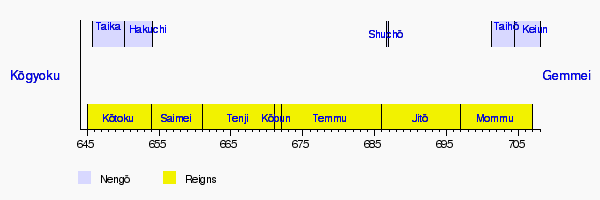Hakuchi (era) facts for kids
Hakuchi (白雉) was a Japanese era name (年号,, nengō,, lit. "year name") after the Taika era and before Shuchō in 686. This period started in February 650 and ended in December 654. The reigning emperor was Kōtoku-tennō (孝徳天皇).
History
In 650 (Taika 6, The daimyo of Nagato Province brought a white pheasant to the court as a gift for the emperor. It was considered to be a good omen, and the emperor caused the nengō to be changed to Hakuchi (meaning "white pheasant").
In Japan, this was the second nengō, which was developed from the Chinese system of eras (nianhao). It became an example of growth in political power.
Timeline
| Timelines of early Japanese nengō and Imperial reign dates |
|---|
 |
The system of Japanese era names was not the same as Imperial reign dates.
Events of the Hakuchi era
- 650 (Hakuchi 1): Kōtoku commanded that all prisoners were to be granted liberty throughout the country.
- 654 (Hakuchi 5, 1st month): A great number of rats moved into Yamato Province; and this was construed as a sign that the capital should be moved.
- 654 (Hakuchi 5): Kōtoku died at the age of 59 after a reign of 5 years during Taika and 5 years during Hakuchi.
Related pages
- National Diet Library, "The Japanese Calendar" -- historical overview plus illustrative images from library's collection
| Hakuchi | 1st | 2nd | 3rd | 4th | 5th |
| Gregorian | 650 | 651 | 652 | 653 | 654 |
| Preceded by: Taika |
Era or nengō: Hakuchi |
Succeeded by: —— |
| Preceded by: —— |
Imperial reign: Kōtoku period 645—654 |
Succeeded by: Saimei period 655—661 |
See also
 In Spanish: Hakuchi (era) para niños
In Spanish: Hakuchi (era) para niños

All content from Kiddle encyclopedia articles (including the article images and facts) can be freely used under Attribution-ShareAlike license, unless stated otherwise. Cite this article:
Hakuchi (era) Facts for Kids. Kiddle Encyclopedia.
